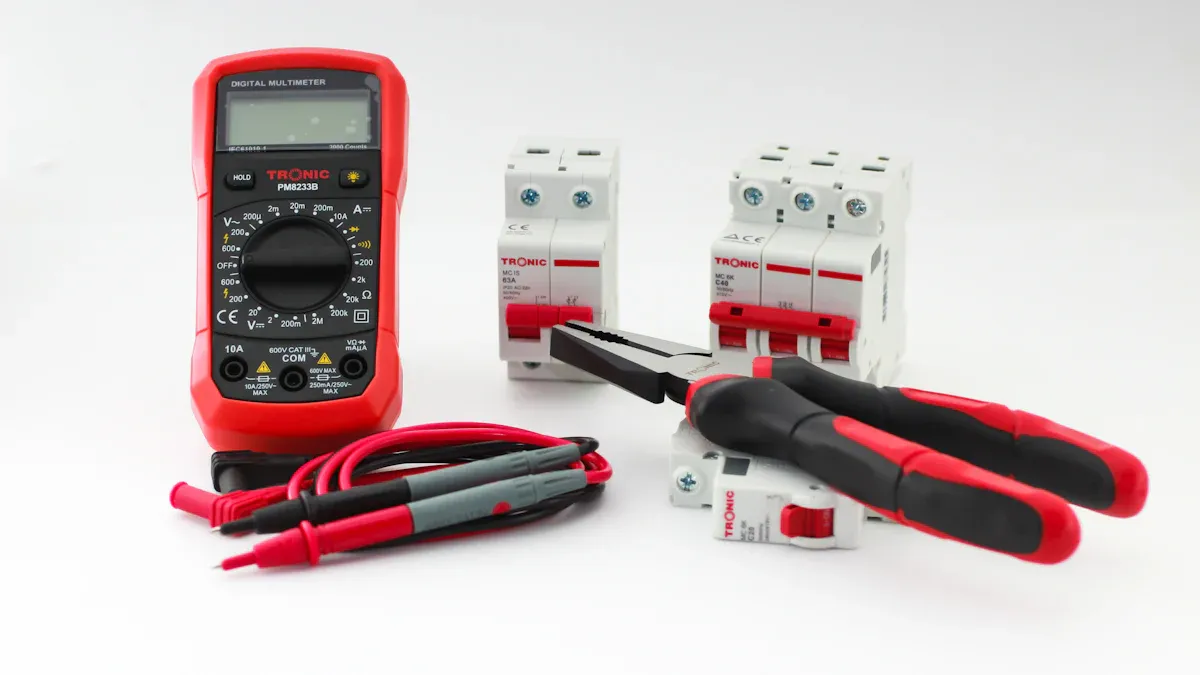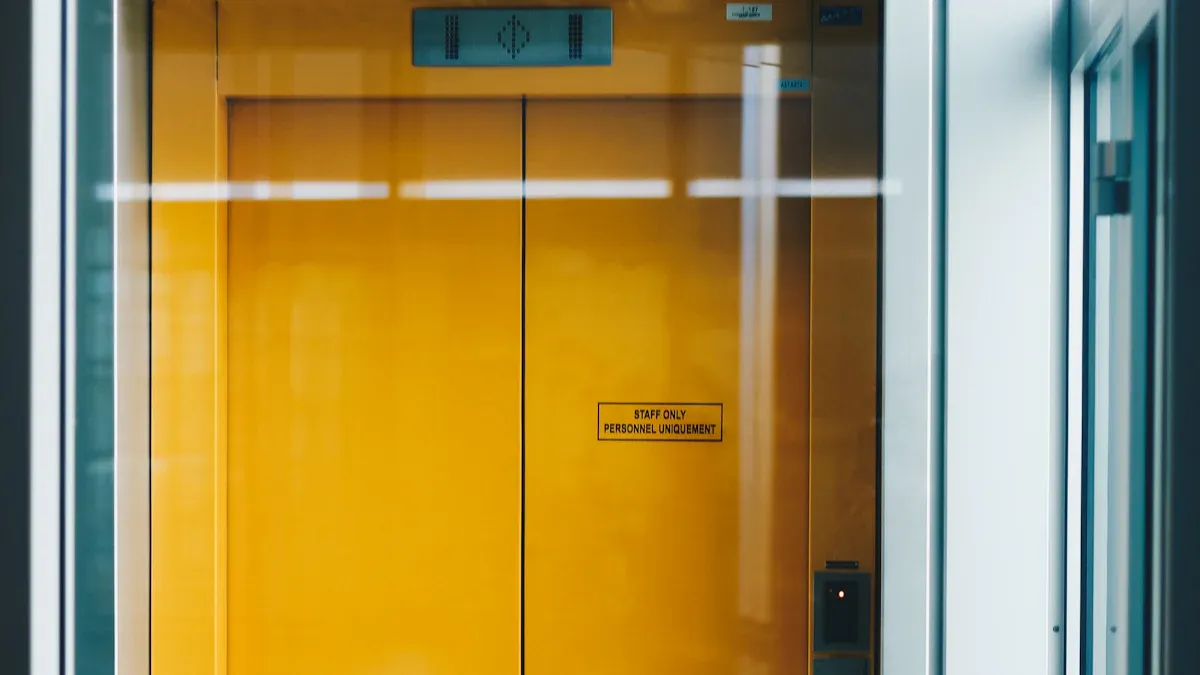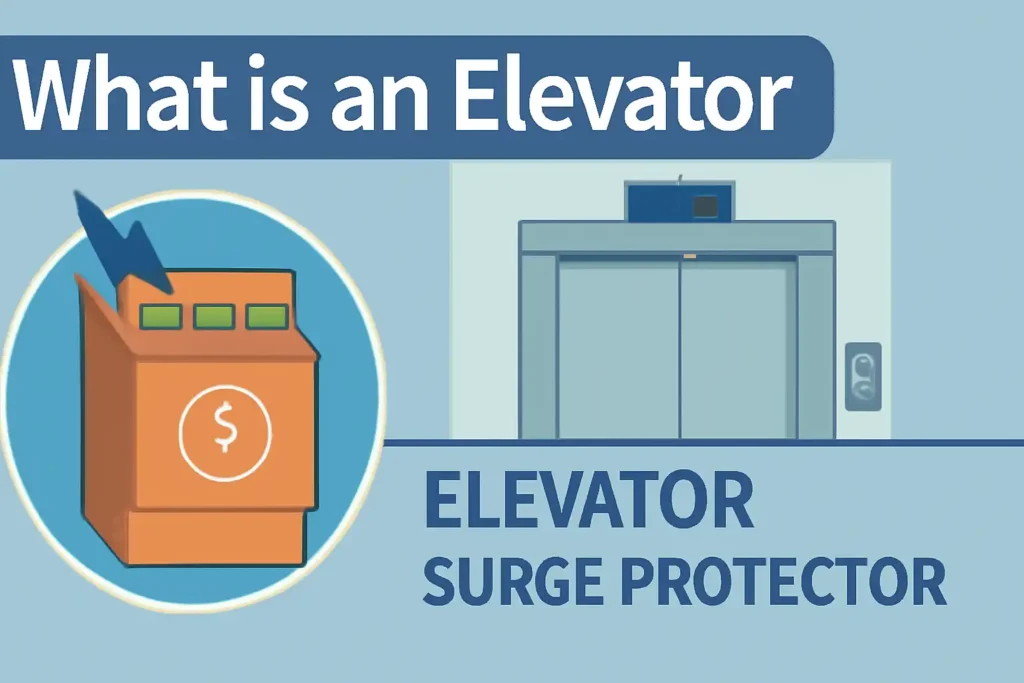A surge protection device for elevators is a special tool. It protects elevator systems from sudden electrical spikes. These spikes can happen due to lightning, power changes, or broken equipment. Without this protection, elevator parts can get damaged. This can lead to expensive repairs and unsafe situations.
Modern elevators use advanced electronics that are easily affected by power changes. Older methods often fail to stop small power surges. This causes frequent problems and repairs. Using new surge protection devices keeps elevators safe, protects passengers, and reduces downtime.
For example, in 1996, a voltage drop caused over 100 complaints. Out of these, 64 cases reported elevators acting strangely. This shows why surge protection is so important.
Key Takeaways
-
Surge protection devices (SPDs) protect elevators from sudden electrical surges. These surges can happen due to lightning or power problems. SPDs help avoid expensive fixes and keep passengers safe.
-
SPDs made for elevators are very important. They manage special issues like motor changes and strong electrical surges. This keeps key parts safe and working well.
-
Checking and maintaining SPDs often is very important. This makes sure they work properly, lowers the chance of elevator problems, and improves safety.
-
Picking the right SPD means choosing ones made for elevators. They should follow safety rules. Experts should install them correctly for the best results.
What Is a Surge Protection Device for Elevators?
General Definition of Surge Protection Devices
A surge protection device (SPD) is a tool that guards electrical systems from sudden voltage increases. These increases, called surges, can happen because of lightning or power problems. SPDs move extra voltage away from important equipment to keep it safe. They are very important for modern electronics, which can easily break from power changes.
There are different types of SPDs for various uses. For example:
-
Transient Voltage Surge Suppressors (TVSS) protect single devices.
-
Point-of-Use (POU) SPDs are placed near the equipment.
-
Whole-Building SPDs protect an entire building’s electrical system.
SPDs must follow rules like UL1449 5th Edition and be UL1449 Listed, as required by NEC/NFPA 70. These rules make sure SPDs work well in different situations.
|
Specification Type |
Details |
|---|---|
|
Market Size (2022) |
|
|
Expected CAGR (2023-2030) |
6.8% |
|
Key Drivers |
Need for SPDs, clean energy programs, power issues, lower electricity costs |
Specific Design for Elevator Systems
Elevators need SPDs made just for their electrical needs. These SPDs are different from regular ones and protect important elevator parts. Elevators use complex systems like control panels, motors, and communication tools. Elevator SPDs keep these parts working even during power surges.
These SPDs handle high-frequency surges caused by motor switching. They also stop damage from outside sources like lightning or power grid changes. Installing these SPDs prevents harm to elevator systems and keeps them running smoothly.
Causes of Electrical Surges in Elevators
Electrical surges in elevators can come from many sources. Knowing these causes helps you protect your elevator systems. Common causes include:
-
Problems with insulation in power networks.
-
Lightning strikes, which send extra voltage through the system.
-
Power grid activities, like capacitor switching.
-
System errors, like short circuits, that interrupt normal work.
These surges can damage elevator systems and risk passenger safety. Using SPDs made for elevators reduces these dangers and keeps operations steady.
Why Are Surge Protection Devices Important for Elevators?

Protecting Elevator Components
Elevators use many electrical parts to work correctly. These include motors, control panels, and communication tools. Electrical surges can harm these parts, causing expensive repairs or replacements. A surge protection device acts like a guard. It moves extra voltage away from important equipment. This keeps your elevator’s key parts safe and working.
These devices also help your elevator parts last longer. They lower the damage caused by electrical surges. This makes your system more reliable. For example:
-
They spot power surges and stop them from reaching key parts.
-
They protect costly equipment, saving you money over time.
-
They reduce damage to wires, keeping the elevator running well.
Rules in the industry stress the need for surge protection. NFPA 780 says surge protection is required for lightning safety systems. UL 96A demands surge protection for electrical setups, including elevators. NEC Article 285 also requires surge devices for emergency systems. These rules make sure elevators stay safe from electrical surges.
|
Source |
Evidence |
|---|---|
|
NFPA 780 |
Requires surge protection as part of lightning protection systems. |
|
UL 96A |
Mandates surge protection for electrical systems, including elevators. |
|
NEC Article 285 |
Requires surge-protective devices for emergency systems in elevators. |
Ensuring Passenger Safety
Keeping passengers safe is the most important part of elevator use. Electrical surges can cause problems like doors not opening or the elevator stopping. These issues can scare people and put them in danger. A surge protection device lowers these risks by keeping the elevator’s systems steady.
With a surge protector, key systems like emergency brakes and communication tools keep working. This is crucial during emergencies when passengers depend on these systems. By stopping problems caused by surges, you make the elevator safer for everyone.
Tip: Test and maintain surge protection devices often. This ensures they work well when needed.
Reducing Downtime and Costs
When elevators stop working, it can disrupt businesses and annoy people. Electrical surges often cause sudden breakdowns that take time and money to fix. A surge protection device helps avoid these issues by shielding the elevator’s systems from harm.
Fewer breakdowns mean the elevator works longer without problems. This improves reliability and lowers repair costs. Surge protectors also prevent damage to expensive parts, saving money over time. This makes them a smart investment for smooth operations.
For businesses, working elevators are very important. They help employees and customers move easily, supporting daily activities. Adding a surge protection device reduces disruptions and keeps everyone happy in your building.
Key Features of Surge Protection Devices for Elevators

Voltage Rating and Compatibility
Surge protection devices must fit your elevator’s voltage needs. Most elevators use voltages below 1000 volts. SPDs designed for this range protect motors and control panels. The NEC requires SPDs to meet UL standards like UL1449 4th Edition. This ensures they work well during power surges.
Elevator SPDs must follow specific voltage rules. For example:
|
Standard |
Requirement |
|---|---|
|
NFPA 70, Article 620.51 |
|
|
SPD Ratings |
SPDs must handle a discharge current of at least 10kA. |
|
Type of SPD |
SPDs must be classified as Type 1 or Type 2. |
Lightning and power surges cause billions of dollars in damage yearly. Using SPDs that match your elevator system prevents costly downtime and protects key parts.
Response Time and Efficiency
Quick response time is important for surge protection. Fast SPDs stop surges before they harm elevator systems. Modern SPDs react in less than one nanosecond (≤ 1ns). This makes them very effective at reducing surge damage.
|
Response Time (tA) |
Line-Line |
L-PG |
|---|---|---|
|
≤ 1ns |
≤ 1ns |
|
|
≤ 25ns |
≤ 25ns |
|
Fast SPDs keep elevator systems reliable and safe. They also help parts last longer, reducing repairs and keeping elevators running smoothly.
Compliance with Standards
SPDs must meet safety rules to protect elevators well. Look for SPDs that follow these standards:
|
Standard |
Description |
|---|---|
|
NEMA-LS1 |
Guide for low voltage AC power SPD applications. |
|
NFPA 780 |
Rules for lightning protection systems. |
|
UL1449 |
Safety rules for surge protection on low voltage AC circuits. |
|
IEEE Std C62.41.1 & C62.41.2 |
Explain surge environments and waveforms; not performance rules. |
These standards prove SPDs are safe and effective. Choosing compliant SPDs improves elevator safety and reliability.
Tip: Check that your SPD is UL Listed and meets current standards for the best protection.
Choosing the Right SPD for Elevators
Picking the right surge protection devices for elevators is very important. Elevators use delicate electrical systems that can break from power surges. The right surge protectors keep key parts safe and elevators running smoothly. Think about these important points:
-
Made for Elevators
Use surge protectors designed just for elevators. These are built to handle things like motor switching and frequent surges. Regular surge protectors might not protect important parts like motors and control panels. -
Installed by Experts
Surge protectors need to be installed the right way. Make sure trained professionals do the job. This ensures the devices work properly and stop surges from harming your elevator systems. -
Check and Maintain Often
Surge protectors need regular checks to work their best. Plan inspections to find problems and replace old parts. This helps avoid failures and keeps your elevator systems safe.
Tip: Write down when you check and fix surge protectors. This helps you stay organized and ensures they always work well.
By following these tips, you can protect elevators from surges, avoid breakdowns, and keep them working safely. Protecting against surges isn’t just about saving equipment—it’s about keeping elevators safe for everyone.
Surge protection devices are important for keeping elevators safe. They protect key parts from power surges, helping them work well. This reduces expensive repairs and keeps elevators running smoothly. Adding SPDs also improves passenger safety and cuts down on delays, saving money over time.
Tip: Check and maintain your SPDs often to keep them working well.
Make sure to upgrade or add surge protection devices to your elevators now. This simple step can protect your equipment and make elevators safer for everyone.
FAQ
What happens if an elevator doesn’t have a surge protection device?
Without an SPD, power surges can harm key parts. Motors and control panels may break, causing frequent issues. Repairs can be expensive, and passengers may face unsafe situations. Adding an SPD keeps elevators safe and working well.
How often should you inspect surge protection devices?
Check SPDs at least once every year. Regular inspections find damage or wear early. This helps the SPD keep protecting your elevator system. It also prevents sudden failures and costly problems.
Can a surge protection device prevent all elevator malfunctions?
SPDs only stop problems caused by electrical surges. They cannot fix mechanical issues or poor maintenance. Combine SPDs with regular checks and servicing for better safety and reliability.
Are surge protection devices required by law?
Yes, many rules like NFPA 780 and NEC Article 285 require SPDs. These rules improve safety and lower risks from power surges. Always follow local codes to keep elevators safe and compliant.
How do you choose the right surge protection device for your elevator?
Pick SPDs made for elevators. Check their voltage range, response speed, and UL1449 compliance. Ask a professional to install it correctly and ensure it fits your system.
Tip: Use SPDs that meet safety standards for the best protection.
You may be interested in the following information
How does SPD deal with strong surge voltage?
What You Need to Know About Surge Protection Device Lifespan
How to test surge protection device equipment



